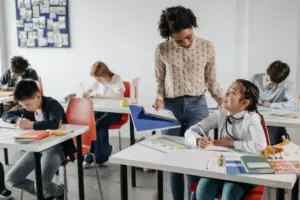This article contains information on the need to reflect after a lesson presentation.

Before my compulsory one year National service (NYSC) [3] in 2018, I dreaded the teaching profession with passion. I prayed against anything that would make me get posted to serve as a teacher. The reason for this is not because I am not friendly and tolerant as it is expected of every teacher but I hated writing lesson notes and also transferring what I have written on the board for students.
Unexpectedly, I ended up serving as a teacher and that which I dreaded most was obviously inevitable. The funny thing was that two weeks after I resumed at the school, I never entered the classroom to teach because I didn’t just know how to go about the whole teaching process. I was worried about whether my students would understand my teachings and lots more. Eventually, I found a way around it and till I concluded my service in the school, students always looked forward to my classes.
One of the secrets to my success as a teacher was the fact that I built a cordial relationship with my students. What if I told you that I knew each of them by their names?
So, based on experience as a former classroom teacher, it is important to note that effective communication is a fundamental aspect of any successful teaching. One crucial element of effective communication is the ability to deliver a lesson or presentation that engages and informs the audience/students.
However, the effectiveness of a presentation is not solely dependent on the presenter’s ability to deliver the content. Taking time to reflect after a presentation plays a vital role in improving the quality of subsequent presentations.
According to Brainly [4], “the PRESENTATION phase of the lesson is when the teacher introduces new information to the class. The teacher guides the presentation, but there may be student input or interaction.
Lesson presentation therefore refers to a sequential learning activity that is carried out to engage the learners. It can be presented orally or with audiovisual aids.
After the lesson presentation, the presenter may decide to think about all that happened in the course of making the presentation. This is known as reflection. Reflection [5] is therefore a process of exploring and examining oneself, our perspectives, attributes, experiences and actions / interactions. This definition supports the idea that reflection is an active process.
In other words, reflection allows people to think back on and learn from their experiences, constructing new knowledge and applying that knowledge to new experiences.
This act helps in the personal growth of the presenter.
In this regard, reflecting on a lesson presentation involves critical evaluation of the presentation, identifying areas for improvement, and making necessary adjustments for future presentations. This process not only helps to improve the quality of the presentation but also enhances the learning outcomes for the audience, resulting in a more successful teaching or training exercise.
But the question is, do people really take time to reflect on their performance after a lesson presentation?
Reflecting after a lesson presentation is important for several reasons which will be seen in this article.
Without further ado, here are the importance of reflecting [2] after a lesson presentation:
1. Self-evaluation
Reflecting on a lesson presentation is a crucial process in the process of improving teaching skills. It allows you as the presenter to evaluate your performance and identify your areas of strength and weakness so that you can improve your teaching skills and become a more effective teacher. To get an effective result, you need to note down every of your presentation, you can use the information to adjust your teaching routine and enhance your teaching techniques
2. Feedback

Reflection is the teacher’s process of assessing how the learners responded to the teaching activity. Hence, reflection provides an opportunity for others to provide feedback on the lesson presentation. This feedback can help the presenter to understand how the audience perceived the presentation and identify areas that need improvement.
Reflection Questions to ask Students
- If we learn this lesson again, what can I do differently to help you learn more or better?
- Did you understand the lesson?
- What do you like about this lesson?
- What did you dislike about this lesson?
3. Identify Gaps
Reflection helps the presenter to identify gaps in knowledge or understanding of the subject matter. This allows the presenter to do further research and improve their understanding, which can lead to a better presentation in the future. On the other hand, it helps you to identify what went well and what could be improved. This information can be used to make changes to your teaching methods in the future.
4. Improved Learning Outcomes
Reflecting on a lesson presentation can help the presenter to identify areas where the audience may have struggled to understand the course presentation. By taking care of these areas in future presentations, the presenter can improve the learning outcomes.
Also it helps you gain a better understanding of your students’ learning needs. By reflecting on how your students responded to the lesson, you can identify areas where they may need additional support.
Back to my story as a teacher during NYSC, my first experience in the classroom wasn’t so palatable. Being a village school, most of my students didn’t understand deep English and that made some of them to be less involved in class. Rather than paying attention in class, they took to playing. I only found out about this when I got worried and spoke to some teachers who were indigenous people.
Upon this discovery, what I did most of the time was to identify the smartest students in class to always interpret words I feel were too ambiguous for them to understand. I was also forced to learn some terms in their language. This was the turning point of my teaching experience.
5. Builds Teacher-Student Relationship

Ideally, teachers are expected to have a good rapport with their students, but where this is not the case, it becomes worrisome for a lot of teachers.
If you want your students to understand your teaching methods [1], it is important to build a healthy relationship with your students.
By reflecting after a lesson presentation, you are able to think about each student as an individual learner with unique needs a d personality.
Overtime, such information can be very beneficial to your teaching experience and your students are more likely to perform better when they feel safe and comfortable Inturn, you will find it easier to engage directly with your students. This is the reason a lot of teachers enjoy the teaching profession
Tips For Reflecting on Lesson Presentation
Here are some tips for reflecting on your lesson presentations:
- Take some time to think about what went well and what could be improved. What were your students’ reactions to the lesson? What were your own reactions to the lesson and your students?
- Talk to your students about their learning. What did they learn from the lesson? What were they confused about?
- Get feedback from colleagues. Ask other teachers what they think of your lesson.
- Video or Record your teaching.
- Capturing the complete lesson can be very useful in the course of reflecting after a lesson presentation. This way, you can take note of every event that occurred during the presentation, ranging from your body language, classroom management, students reaction and attentiveness, etc. The good thing about this is that it shows you some things you didn’t notice when you were teaching.
Conclusion
Overall, reflecting on a lesson presentation is an important step in improving the quality of future presentations and enhancing the learning experience for the audience.
It is an important part of the teaching process. By taking the time to reflect on your lesson presentations, you can improve your teaching skills and become a more professional teacher.
References
[1] “Best Teaching Philosophy to Adopt in 2023.” Explore the Best of East Africa, Eafinder, 31 Aug. 2020, https://www.eafinder.com/best-teaching-philosophy-to-adopt/.
[2] “Importance of Reflection as a Teacher.” EWU, 27 Feb. 2023, https://online.ewu.edu/degrees/education/med/curriculum-and-instruction/importance-of-reflection-as-teacher/.
[3] “NYSC – About Scheme.” Gov.Ng, https://nysc.gov.ng/aboutscheme.htm
[4] Brainly.Ph, https://brainly.ph/question/12816817.
[5] Ed.ac.uk, http://www.docs.hss.ed.ac.uk/iad/Learning_teaching/Academic_pastoral/Reflect/Reflection_explanation_HO.pdf.
Don’t miss out on current updates, kindly like us on Facebook & follow us on Follow @EAfinder OR leave a comment below for further inquiries.






